
The Collegiate Church of Santa Maria Assunta, San Gimignano is a Roman Catholic collegiate church and minor basilica located in San Gimignano, Tuscany, central Italy, situated in the Piazza del Duomo at the town's heart. The church is famous for its fresco cycles which include works by Domenico Ghirlandaio, Benozzo Gozzoli, Taddeo di Bartolo, Lippo Memmi and Bartolo di Fredi. The basilica is located within the UNESCO World Heritage Site of the "Historic Centre of San Gimignano", with its frescos being described by UNESCO as "works of outstanding beauty".
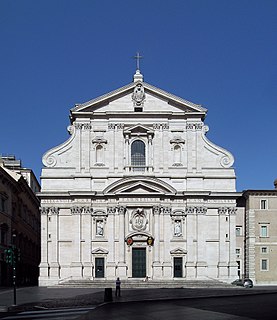
The Church of the Gesù is the mother church of the Society of Jesus (Jesuits), a Catholic religious order. Officially named Chiesa del Santissimo Nome di Gesù all'Argentina, its facade is "the first truly baroque façade", introducing the baroque style into architecture. The church served as model for innumerable Jesuit churches all over the world, especially in the Americas. Its paintings in the nave, crossing, and side chapels became models for Jesuit churches throughout Italy and Europe, as well as those of other orders. The Church of the Gesù is located in the Piazza del Gesù in Rome.
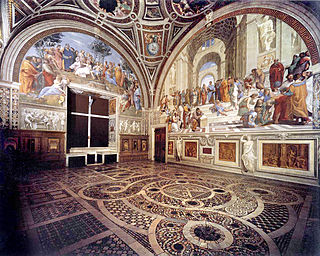
The four Raphael Rooms form a suite of reception rooms, now part of the Vatican Museums in Vatican City. They are famous for their frescoes, painted by Raphael and his workshop. Together with Michelangelo's Sistine Chapel ceiling frescoes, they are the grand fresco sequences that mark the High Renaissance in Rome.
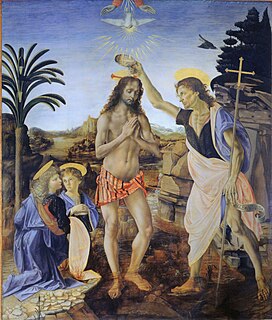
The Baptism of Christ is a painting finished around 1475 in the studio of the Italian Renaissance painter Andrea del Verrocchio and generally ascribed to him and his pupil Leonardo da Vinci. Some art historians discern the hands of other members of Verrocchio's workshop in the painting as well.
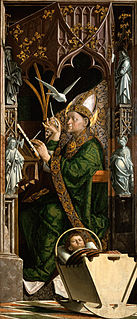
Michael Pacher was a painter and sculptor from Tyrol active during the second half of the fifteenth century. He was one of the earliest artists to introduce the principles of Renaissance painting into Germany. Pacher was a comprehensive artist with a broad range of sculpting, painting, and architecture skills producing works of complex wood and stone. He painted structures for altarpieces on a scale unparalleled in North European art.

The Brancacci Chapel is a chapel in the Church of Santa Maria del Carmine in Florence, central Italy. It is sometimes called the "Sistine Chapel of the early Renaissance" for its painting cycle, among the most famous and influential of the period. Construction of the chapel was commissioned by Felice Brancacci and begun in 1422. The paintings were executed over the years 1425 to 1427. Public access is currently gained via the neighbouring convent, designed by Brunelleschi. The church and the chapel are treated as separate places to visit and as such have different opening times and it is quite difficult to see the rest of the church from the chapel.

The Disputation of the Sacrament, or Disputa, is a painting by the Italian Renaissance artist Raphael. It was painted between 1509 and 1510 as the first part of Raphael's commission to decorate with frescoes the rooms that are now known as the Stanze di Raffaello, in the Apostolic Palace in the Vatican. At the time, this room was known as the Stanza della Segnatura, and was the private papal library where the supreme papal tribunal met.

Minor Basilica of the Immaculate Heart of Mary, is a titular church in Piazza Euclide, Rome. It was built by the architect Armando Brasini (1879–1965). Its construction began in 1923 with the design of a Greek cross inscribed in a circle with an articulated facade, and completed before 1936, the year in which it was made a parish church and granted to the Congregation of Missionary Sons of the Sacred Immaculate Heart of Mary, usually known as the Claretian Missionaries. A grand dome was planned, but never realized; a smaller drum was completed in 1951.

Agostino Ciampelli was an Italian painter of the Baroque period. He trained with Santi di Tito in Florence, and painted in Rome under Clement VIII, including a Crucifixion for Santa Prassede and a Saint Giovanni Gualberto in its sacristy; Angels on the walls above the choirstalls in the apse of Santa Maria in Trastevere; frescoes of the Stoning of Saint Vitale in San Vitale and further frescoes in the little church of Santa Bibiena; and The Visitation in Sant Stefano di Pescia. At the Basilica of San Giovanni in Laterano, Ciampelli frescoed the walls of the canons' sacristy, the "Sala Clementina".

The Baptism of Christ is a painting by the Italian Renaissance master Piero della Francesca. Painted in egg tempera on two panels of poplar wood, the dating is controversial – some give it a very early date, perhaps 1439; others much later, around 1460. It is held by the National Gallery, London.

The circumcision of Jesus is an event from the life of Jesus, according to the Gospel of Luke chapter 2, which states in verse 21 that Jesus was circumcised eight days after his birth. This is in keeping with the Jewish law which holds that males should be circumcised eight days after birth during a Brit milah ceremony, at which they are also given their name. The circumcision of Christ became a very common subject in Christian art from the 10th century onwards, one of numerous events in the Life of Christ to be frequently depicted by artists. It was initially seen only as a scene in larger cycles, but by the Renaissance might be treated as an individual subject for a painting, or form the main subject in an altarpiece.

The Coronation of the Virgin is a painting of the Coronation of the Virgin by the Italian Renaissance master Filippo Lippi, in the Uffizi, Florence.

The Baptism of Christ is a fresco by the Italian Renaissance painter Pietro Perugino and his workshop, executed around 1482 and located in the Sistine Chapel, Rome.

The Apse of Sant Climent de Taüll is a Romanesque fresco in the National Art Museum of Catalonia, Barcelona. This is one of the masterpieces of the European Romanesque. from which the unknown Master of Taüll takes his name. Painted in the early 12th century, it was in the church of Sant Climent de Taüll at the Vall de Boí, Alta Ribagorça in the Catalan Pyrenees until removed in 1919-1923, along with other parts of the fresco decoration, in an attempt to preserve the paintings by placing them in a stable, secure museum setting.

San Lio is a church located on the campo of the same name in the sestiere of Castello.
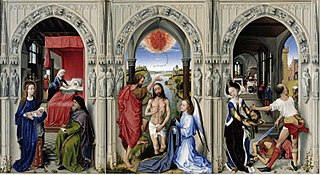
The St John Altarpiece is a c. 1455 oil-on-oak wood panel altarpiece by the Early Netherlandish painter Rogier van der Weyden, now in the Gemäldegalerie, Berlin. The triptych is linked to the artist's earlier Miraflores Altarpiece in its symbolic motifs, format and intention.

Sant'Eufemia is a Roman Catholic church located in the island of Giudecca in Venice, Veneto, Italy and dedicated to saint Euphemia.

The Baptism of Christ is a casein tempera and gold on canvas painting, measuring 176 by 230 cm and dating to around 1506. It and The Holy Family and the Family of Saint John the Baptist were painted by Andrea Mantegna for his funerary chapel at the Basilica of Sant'Andrea, Mantua - the chapel was dedicated to John the Baptist, hence the choice of subjects. They were both found in his studio after his death by his son Francesco and placed in the chapel, where they still hang.
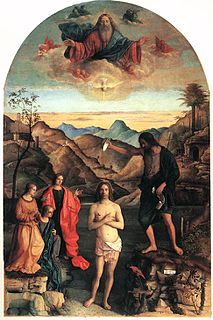
Baptism of Christ is a tempera painting on panel by Giovanni Bellini, dating to 1500–1502, and now located in the Chiesa di Santa Corona in Vicenza. It is signed IOANNES / BELLINVS on a rock in the lower left.

The Sant'Agostino Altarpiece is a painting by Perugino, produced in two stages between around 1502 and 1512 and then around 1513 to 1523. The altarpiece's 28, 29 or 30 panels were split up during the Napoleonic suppression of religious houses - most of its panels are now in the Galleria Nazionale dell'Umbria in Perugia. It is notable as the painter's last masterwork before he moved into his late phase producing more provincial commissions.




















